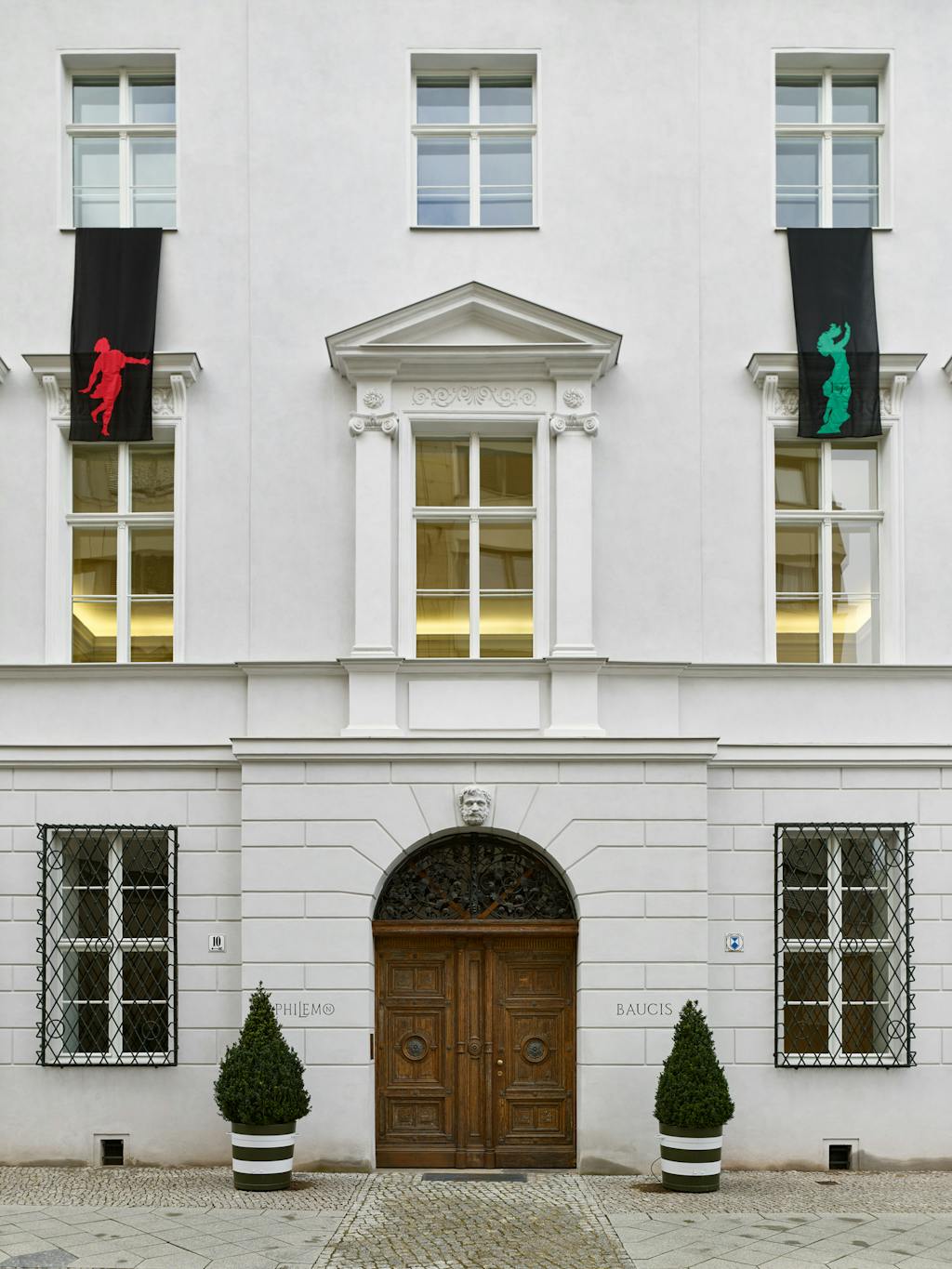Following exhibitions in Frechen (1988, 1990), Cologne (2006) and Palma de Mallorca (2009), ‘Et in Arcadia ego’ will be the first solo presentation of Finlay’s works in the Berlin gallery.
Born in Nassau, Bahamas in 1925, Finlay went to school in Scotland, carried out military service there and then attended the Glasgow School of Art. When he began writing short stories and poems, he was working as a shepherd. He published his first book, The Sea Bed and Other Stories, in 1958, and in 1963 his first volume of poetry, Rapel, that earned him international renown. From 1966 onward the poet lived in his Scottish refuge Stonypath in the Pentland Hills. Over the years, he developed the estate’s gardens – which he called Little Sparta – into a poetic synthesis of the arts with plants, stone reliefs, sculpture, fragments of Neoclassicist-style temples and landscape design distinguished by precision down to the smallest detail. To this day, Little Sparta is considered one of the masterpieces of modern British horticulture. Since 1972, Finlay’s sculptural works have been installed in public and private parks, gardens and buildings in many European countries. The Kewenig show will present Cubes (1987); Kapitell (1989), and A/or, Unit, Signs (1989) on the gallery’s ground floor and in its garden.
On the first exhibition floor of the gallery, the neon work Je Vous Salue Marat will greet the visitor with the colours of the French tricolour: Finlay executed it in 1989 on the occasion of the two-hundredth anniversary of the French Revolution. This large work complex invokes the bloody consequences of a series of events that began as a struggle for freedom, equality and brotherhood and ended in a dictatorship. Sentences such as “Terror is the piety of revolution” reveal Finlay’s stance on the French Revolution as historical proof of the coexistence of violence and clarity of thought. Jean Paul Marat (1743–1793), one of the French Revolution’s most infamous demagogues, turns up repeatedly in Finlay’s prints – for example the lithographs Marat Assassiné (with Gary Hincks) (1986) and Head of the Dead Marat (with Gary Hincks) (1987) – as a quotation from Jacques Louis David’s Neoclassicist masterwork The Death of Marat (1793).
Concrete poetry forms the core and beginning of Ian Hamilton Finlay’s œuvre. Images and words combine with elements from nature, art and the history of culture and manifest the interdependency between visual depiction and the meaning of the written word. Over the course of forty-five years, in the Wild Hawthorn Press publishing company he founded in 1961 and in his magazine Poor. Old. Tired. Horse, Finlay published booklets, postcards and posters in more than a thousand different forms in collaboration with well-known artists. These images and writings – graphically designed poems and so-called Poster Poems, aphorisms and neologisms, but also allegorical paintings and drawings – still distinctly characterize his early works of the 1960s as concrete poetry. His later text-image works, on the other hand, are closer to visual poetry in style. They are references to prominent protagonists and disastrous events of Occidental history. Walter Benjamin’s proposition “There is no document of culture that is not at the same time a document of barbarism”[2] demarcates the scope of the core themes of Occidental cultural history addressed by the works in the exhibition: the arcadian conceptions of the seventeenth century, the virtuous ideals and violent excesses of the French Revolution and Neoclassicism, and the appropriation of the latter by National Socialism. In a formal language all his own, Finlay anti-modernistically defied the twentieth-century avant-garde’s dictate of abstraction. His vocabulary of motifs unites depictions of wildflowers, the Greek gods and idyllic seascapes with images of battleships, guillotines and tanks, and enriches these instances of syncretism with contents of a political as well as a philosophical nature.
The exhibition title ‘Et in Arcadia ego’ – which Finlay himself used in various works – points to a motif often quoted in literature, painting and garden art since the Renaissance. The French Baroque painter Nicolas Poussin made reference to it in the two versions of his painting The Arcadian Shepherds (1630/1640), showing a group shepherds standing around a sarcophagus in a classical landscape. In 1935 and 1951, Erwin Panofsky wrote two paradigmatic essays on Poussin’s Arcadia works that had a decisive impact on Finlay’s repeated employment of the motif from the late 1970s onward.[3] Arcadia was already glorified in ancient Greece as a topos where, remote from society and its constraints, a shepherd could live in harmony with idyllic nature. Yet the omnipresence of death shatters the dream of freedom dreamt by the mythological creatures in Arcadia. Finlay made frequent allusion to the realm of the gods as described in Ovid’s Metamorphoses and Virgil’s narratives, and paid tribute to the latter author with his Virgil bricks (1987) and the painting Hanging Virgil (with Ron Costley) (1987). His reception of the mythological motif of Apollo and Daphne is manifest in various derivations from Gian Lorenzo Bernini’s Baroque sculpture of 1622–1625 in the form of wall reliefs and prints.
Finlay was nominated for the Turner Prize in 1985. In 2012, the Tate Britain London devoted a comprehensive exhibition to the artist. His works are represented worldwide in the most important international and private collections.
[1] A reference to the Finlay’s stone medallions bearing the same names that lined the approach to the gallery in Frechen.
[2] Walter Benjamin, Selected Writings, vol. 4, 1938–1940, edited by Howard Eiland and Michael W. Jennings, trans. Edmund Jephcott et al. (Cambridge, 2003), p. 392.
[3] See Erwin Panofsky: “Et in Arcadia ego: Poussin and the Elegiac Tradition”, idem, Meaning in the Visual Arts (Garden City, 1955).
